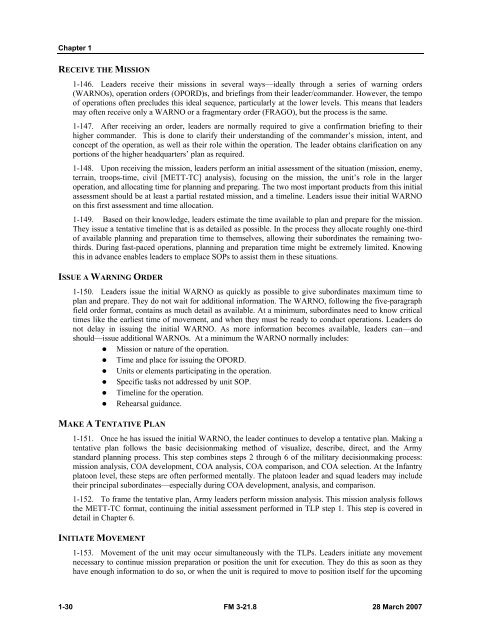Infantry Rifle Platoon and Squad - Sakai
Infantry Rifle Platoon and Squad - Sakai
Infantry Rifle Platoon and Squad - Sakai
Create successful ePaper yourself
Turn your PDF publications into a flip-book with our unique Google optimized e-Paper software.
Chapter 1<br />
RECEIVE THE MISSION<br />
1-146. Leaders receive their missions in several ways—ideally through a series of warning orders<br />
(WARNOs), operation orders (OPORD)s, <strong>and</strong> briefings from their leader/comm<strong>and</strong>er. However, the tempo<br />
of operations often precludes this ideal sequence, particularly at the lower levels. This means that leaders<br />
may often receive only a WARNO or a fragmentary order (FRAGO), but the process is the same.<br />
1-147. After receiving an order, leaders are normally required to give a confirmation briefing to their<br />
higher comm<strong>and</strong>er. This is done to clarify their underst<strong>and</strong>ing of the comm<strong>and</strong>er’s mission, intent, <strong>and</strong><br />
concept of the operation, as well as their role within the operation. The leader obtains clarification on any<br />
portions of the higher headquarters’ plan as required.<br />
1-148. Upon receiving the mission, leaders perform an initial assessment of the situation (mission, enemy,<br />
terrain, troops-time, civil [METT-TC] analysis), focusing on the mission, the unit’s role in the larger<br />
operation, <strong>and</strong> allocating time for planning <strong>and</strong> preparing. The two most important products from this initial<br />
assessment should be at least a partial restated mission, <strong>and</strong> a timeline. Leaders issue their initial WARNO<br />
on this first assessment <strong>and</strong> time allocation.<br />
1-149. Based on their knowledge, leaders estimate the time available to plan <strong>and</strong> prepare for the mission.<br />
They issue a tentative timeline that is as detailed as possible. In the process they allocate roughly one-third<br />
of available planning <strong>and</strong> preparation time to themselves, allowing their subordinates the remaining twothirds.<br />
During fast-paced operations, planning <strong>and</strong> preparation time might be extremely limited. Knowing<br />
this in advance enables leaders to emplace SOPs to assist them in these situations.<br />
ISSUE A WARNING ORDER<br />
1-150. Leaders issue the initial WARNO as quickly as possible to give subordinates maximum time to<br />
plan <strong>and</strong> prepare. They do not wait for additional information. The WARNO, following the five-paragraph<br />
field order format, contains as much detail as available. At a minimum, subordinates need to know critical<br />
times like the earliest time of movement, <strong>and</strong> when they must be ready to conduct operations. Leaders do<br />
not delay in issuing the initial WARNO. As more information becomes available, leaders can—<strong>and</strong><br />
should—issue additional WARNOs. At a minimum the WARNO normally includes:<br />
• Mission or nature of the operation.<br />
• Time <strong>and</strong> place for issuing the OPORD.<br />
• Units or elements participating in the operation.<br />
• Specific tasks not addressed by unit SOP.<br />
• Timeline for the operation.<br />
• Rehearsal guidance.<br />
MAKE A TENTATIVE PLAN<br />
1-151. Once he has issued the initial WARNO, the leader continues to develop a tentative plan. Making a<br />
tentative plan follows the basic decisionmaking method of visualize, describe, direct, <strong>and</strong> the Army<br />
st<strong>and</strong>ard planning process. This step combines steps 2 through 6 of the military decisionmaking process:<br />
mission analysis, COA development, COA analysis, COA comparison, <strong>and</strong> COA selection. At the <strong>Infantry</strong><br />
platoon level, these steps are often performed mentally. The platoon leader <strong>and</strong> squad leaders may include<br />
their principal subordinates—especially during COA development, analysis, <strong>and</strong> comparison.<br />
1-152. To frame the tentative plan, Army leaders perform mission analysis. This mission analysis follows<br />
the METT-TC format, continuing the initial assessment performed in TLP step 1. This step is covered in<br />
detail in Chapter 6.<br />
INITIATE MOVEMENT<br />
1-153. Movement of the unit may occur simultaneously with the TLPs. Leaders initiate any movement<br />
necessary to continue mission preparation or position the unit for execution. They do this as soon as they<br />
have enough information to do so, or when the unit is required to move to position itself for the upcoming<br />
1-30 FM 3-21.8 28 March 2007

















